
Artist’s impression of two black holes merging, which can be detected on Earth through the gravitational waves the collision creates.
Lynette Cook/Science Source
A U.S. gravitational wave detector spotted a collision between fast-spinning “forbidden” black holes that challenge physics models

Artist’s impression of two black holes merging, which can be detected on Earth through the gravitational waves the collision creates.
Lynette Cook/Science Source
Jonathan O'Callaghan is an award-winning freelance journalist covering astronomy, astrophysics, commercial spaceflight and space exploration. Follow him on X @Astro_Jonny
First published in 1869, Nature is the world's leading multidisciplinary science journal. Nature publishes the finest peer-reviewed research that drives ground-breaking discovery, and is read by thought-leaders and decision-makers around the world.
[enclosures] => Array ( ) [categories] => Array ( ) [uid] => [link] => https://www.scientificamerican.com/article/monster-black-hole-merger-is-most-massive-ever-seen/ [description] =>A U.S. gravitational wave detector spotted a collision between fast-spinning ‘forbidden’ black holes that challenge physics models
[pubDate] => Tue, 15 Jul 2025 17:00:00 +0000 [guid] => https://www.scientificamerican.com/article/monster-black-hole-merger-is-most-massive-ever-seen/ ) [1] => Array ( [uri] => https://www.scientificamerican.com/article/how-influenza-reassortment-may-make-bird-flu-more-dangerous/ [title] => How Influenza Reassortment May Make Bird Flu More Dangerous [timestamp] => 1752530400 [author] => Stephanie Pappas; Jeanna Bryner [content] =>Influenza viruses like bird flu can mix and match their genomes, and this has played a role in at least three of the last four flu pandemics
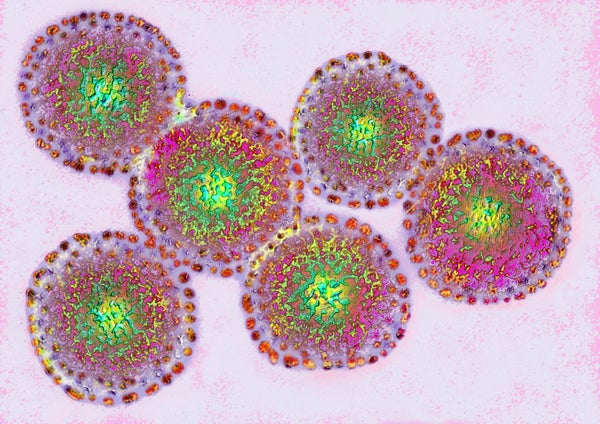
Avian influenza, a virus of the orthomyxoviridae family. The flu virus causes an infectious and contagious respiratory disease, and often results in a pandemic and/or smaller seasonal epidemic.
James Cavallini/Science Source
Stephanie Pappas is a freelance science journalist based in Denver, Colo.
[enclosures] => Array ( ) [categories] => Array ( ) [uid] => [link] => https://www.scientificamerican.com/article/how-influenza-reassortment-may-make-bird-flu-more-dangerous/ [description] =>Influenza viruses like bird flu can mix and match their genomes, and this has played a role in at least three of the last four flu pandemics
[pubDate] => Tue, 15 Jul 2025 13:00:00 +0000 [guid] => https://www.scientificamerican.com/article/how-influenza-reassortment-may-make-bird-flu-more-dangerous/ ) [2] => Array ( [uri] => https://www.scientificamerican.com/article/earths-poles-have-shifted-because-of-water-dams/ [title] => Earth’s Poles Have Shifted because of Water Dams [timestamp] => 1752530400 [author] => Andrea Tamayo; Andrea Thompson [content] =>When large masses of water are moved from one place to another, this changes the shape of Earth and leads to a phenomenon called true polar wander

Star trails above the Three Gorges Dam in Yichang, Hubei province, China. Large dams like this one are shifting the Earth's poles away from its axis of rotation.
Cynthia Lee/Alamy Stock Photo
Andrea Tamayo is the current newsletter and engagement intern at Scientific American and a freelance science writer. Follow Tamayo on Bluesky @andreatamayo.bsky.social
[enclosures] => Array ( ) [categories] => Array ( ) [uid] => [link] => https://www.scientificamerican.com/article/earths-poles-have-shifted-because-of-water-dams/ [description] =>When large masses of water are moved from one place to another, this changes the shape of Earth and leads to a phenomenon called true polar wander
[pubDate] => Tue, 15 Jul 2025 10:30:00 +0000 [guid] => https://www.scientificamerican.com/article/earths-poles-have-shifted-because-of-water-dams/ ) [3] => Array ( [uri] => https://www.scientificamerican.com/article/doctors-discover-new-blood-type-and-only-one-person-has-it/ [title] => Doctors Discover New Blood Type—And Only One Person Has It [timestamp] => 1752530400 [author] => Martin L. Olsson; Jill Storry; The Conversation US [content] =>Newly discovered “Gwada-negative” is the rarest of 48 known blood groups
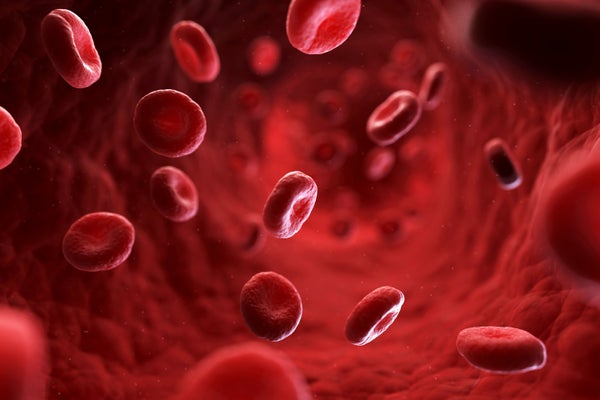
SciePro/Getty Images
Martin L. Olsson is a professor of transfusion medicine at Lund University and medical director of the Nordic Reference Laboratory for Blood Group Genomics at Region Skåne in Lund, Sweden.
Jill Storry is an adjunct professor at the Division of Transfusion Medicine at Lund University, Sweden, and technical director of the Immunohematology laboratories of Region Skåne, Lund.
Curated by professional editors, The Conversation offers informed commentary and debate on the issues affecting our world.
[enclosures] => Array ( ) [categories] => Array ( ) [uid] => [link] => https://www.scientificamerican.com/article/doctors-discover-new-blood-type-and-only-one-person-has-it/ [description] =>Newly discovered “Gwada-negative” is the rarest of 48 known blood groups
[pubDate] => Tue, 15 Jul 2025 11:00:00 +0000 [guid] => https://www.scientificamerican.com/article/doctors-discover-new-blood-type-and-only-one-person-has-it/ ) [4] => Array ( [uri] => https://www.scientificamerican.com/article/pneumonic-plague-infections-in-modern-times-show-the-black-death-isnt-dead/ [title] => Pneumonic Plague Infections in Modern Times Show the Black Death Isn’t Dead [timestamp] => 1752530400 [author] => Lauren J. Young; Dean Visser [content] =>A person in Arizona recently died of pneumonic plague—a rare and severe form of the disease. An expert explains how the bacteria that spurred the Black Death centuries ago continues to claim lives
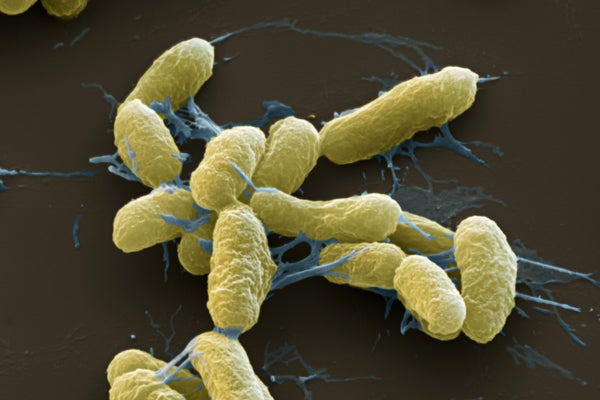
Yersinia pestis.
Eye of Science/Science Source
Lauren J. Young is an associate editor for health and medicine at Scientific American. She has edited and written stories that tackle a wide range of subjects, including the COVID pandemic, emerging diseases, evolutionary biology and health inequities. Young has nearly a decade of newsroom and science journalism experience. Before joining Scientific American in 2023, she was an associate editor at Popular Science and a digital producer at public radio’s Science Friday. She has appeared as a guest on radio shows, podcasts and stage events. Young has also spoken on panels for the Asian American Journalists Association, American Library Association, NOVA Science Studio and the New York Botanical Garden. Her work has appeared in Scholastic MATH, School Library Journal, IEEE Spectrum, Atlas Obscura and Smithsonian Magazine. Young studied biology at California Polytechnic State University, San Luis Obispo, before pursuing a master’s at New York University’s Science, Health & Environmental Reporting Program.
[enclosures] => Array ( ) [categories] => Array ( ) [uid] => [link] => https://www.scientificamerican.com/article/pneumonic-plague-infections-in-modern-times-show-the-black-death-isnt-dead/ [description] =>A person in Arizona recently died of pneumonic plague—a rare and severe form of the disease. An expert explains how the bacteria that spurred the Black Death centuries ago continues to claim lives
[pubDate] => Tue, 15 Jul 2025 16:45:00 +0000 [guid] => https://www.scientificamerican.com/article/pneumonic-plague-infections-in-modern-times-show-the-black-death-isnt-dead/ ) [5] => Array ( [uri] => https://www.scientificamerican.com/article/bird-flu-is-out-of-the-news-but-still-circulating/ [title] => Bird Flu Is out of the News but Still Circulating [timestamp] => 1752530400 [author] => Meghan Bartels; Lauren J. Young [content] =>Bird flu was nearly everywhere in the U.S.—in chickens, cows, pet cats and even humans. Cases have gone down, but experts warn that it hasn’t disappeared
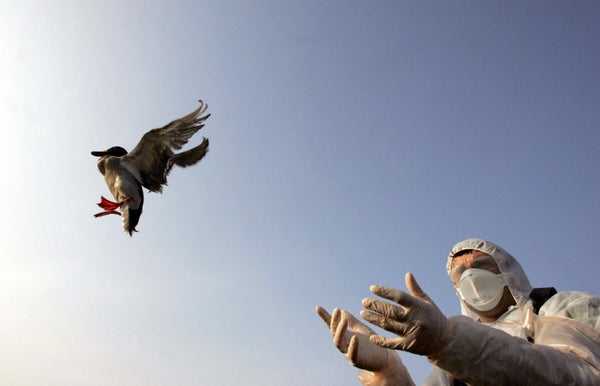
A French scientist frees a wild duck after testing for avian influenza viruses.
Dominique Faget/AFP via Getty Images
Meghan Bartels is a science journalist based in New York City. She joined Scientific American in 2023 and is now a senior news reporter there. Previously, she spent more than four years as a writer and editor at Space.com, as well as nearly a year as a science reporter at Newsweek, where she focused on space and Earth science. Her writing has also appeared in Audubon, Nautilus, Astronomy and Smithsonian, among other publications. She attended Georgetown University and earned a master’s degree in journalism at New York University’s Science, Health and Environmental Reporting Program.
[enclosures] => Array ( ) [categories] => Array ( ) [uid] => [link] => https://www.scientificamerican.com/article/bird-flu-is-out-of-the-news-but-still-circulating/ [description] =>Bird flu was nearly everywhere in the U.S.—in chickens, cows, pet cats and even humans. Cases have gone down, but experts warn that it hasn’t disappeared
[pubDate] => Tue, 15 Jul 2025 13:00:00 +0000 [guid] => https://www.scientificamerican.com/article/bird-flu-is-out-of-the-news-but-still-circulating/ ) [6] => Array ( [uri] => https://www.scientificamerican.com/article/could-bird-flu-spread-between-humans-heres-what-it-would-take/ [title] => Could Bird Flu Spread between Humans? Here’s What It Would Take [timestamp] => 1752530400 [author] => Stephanie Pappas; Jeanna Bryner [content] =>The H5N1 avian flu is circulating in cows and other mammals. Whether it will make a permanent leap to humans is another question

vm/Getty Images
Stephanie Pappas is a freelance science journalist based in Denver, Colo.
[enclosures] => Array ( ) [categories] => Array ( ) [uid] => [link] => https://www.scientificamerican.com/article/could-bird-flu-spread-between-humans-heres-what-it-would-take/ [description] =>The H5N1 avian flu is circulating in cows and other mammals. Whether it will make a permanent leap to humans is another question
[pubDate] => Tue, 15 Jul 2025 13:00:00 +0000 [guid] => https://www.scientificamerican.com/article/could-bird-flu-spread-between-humans-heres-what-it-would-take/ ) [7] => Array ( [uri] => https://www.scientificamerican.com/article/bird-flu-is-killing-wildlife-and-experts-fear-the-ecological-toll/ [title] => Bird Flu Is Killing Wildlife, and Experts Fear the Ecological Toll [timestamp] => 1752530400 [author] => Meghan Bartels; Andrea Thompson [content] =>Bird flu fears have focused on the poultry and dairy industries and human health. But wild animals are threatened, too—at scales no one fully understands

A flock of Snow Geese in flight.
Jean Landry / Alamy Stock Photo
Meghan Bartels is a science journalist based in New York City. She joined Scientific American in 2023 and is now a senior news reporter there. Previously, she spent more than four years as a writer and editor at Space.com, as well as nearly a year as a science reporter at Newsweek, where she focused on space and Earth science. Her writing has also appeared in Audubon, Nautilus, Astronomy and Smithsonian, among other publications. She attended Georgetown University and earned a master’s degree in journalism at New York University’s Science, Health and Environmental Reporting Program.
[enclosures] => Array ( ) [categories] => Array ( ) [uid] => [link] => https://www.scientificamerican.com/article/bird-flu-is-killing-wildlife-and-experts-fear-the-ecological-toll/ [description] =>Bird flu fears have focused on the poultry and dairy industries and human health. But wild animals are threatened, too—at scales no one fully understands
[pubDate] => Tue, 15 Jul 2025 13:00:00 +0000 [guid] => https://www.scientificamerican.com/article/bird-flu-is-killing-wildlife-and-experts-fear-the-ecological-toll/ ) [8] => Array ( [uri] => https://www.scientificamerican.com/article/science-crossword-on-the-fly/ [title] => Science Crossword: On the Fly [timestamp] => 1752530400 [author] => Aimee Lucido [content] =>Aimee Lucido makes crosswords part-time for several outlets and writes trivia full-time for Bloomberg's news quiz, Pointed. She is also the author of several books for kids, including Emmy in the Key of Code, Recipe for Disaster, and Pasta Pasta Lotsa Pasta. Lucido lives with her husband, daughter and dog in New York.
[enclosures] => Array ( ) [categories] => Array ( ) [uid] => [link] => https://www.scientificamerican.com/article/science-crossword-on-the-fly/ [description] =>Your favorite word game with a twist of science
[pubDate] => Tue, 15 Jul 2025 13:00:00 +0000 [guid] => https://www.scientificamerican.com/article/science-crossword-on-the-fly/ ) [9] => Array ( [uri] => https://www.scientificamerican.com/article/what-new-biological-age-clocks-say-about-longevity-according-to-eric-topol/ [title] => What New Biological Age ‘Clocks’ Say about Longevity, according to Eric Topol [timestamp] => 1752444000 [author] => Lauren J. Young; Dean Visser [content] =>Super Agers author Eric Topol unpacks the rise of biological age tests—from organ clocks to immune system clocks—and how they might revolutionize early diagnosis of disease

DNY59/Getty Images
Lauren J. Young is an associate editor for health and medicine at Scientific American. She has edited and written stories that tackle a wide range of subjects, including the COVID pandemic, emerging diseases, evolutionary biology and health inequities. Young has nearly a decade of newsroom and science journalism experience. Before joining Scientific American in 2023, she was an associate editor at Popular Science and a digital producer at public radio’s Science Friday. She has appeared as a guest on radio shows, podcasts and stage events. Young has also spoken on panels for the Asian American Journalists Association, American Library Association, NOVA Science Studio and the New York Botanical Garden. Her work has appeared in Scholastic MATH, School Library Journal, IEEE Spectrum, Atlas Obscura and Smithsonian Magazine. Young studied biology at California Polytechnic State University, San Luis Obispo, before pursuing a master’s at New York University’s Science, Health & Environmental Reporting Program.
[enclosures] => Array ( ) [categories] => Array ( ) [uid] => [link] => https://www.scientificamerican.com/article/what-new-biological-age-clocks-say-about-longevity-according-to-eric-topol/ [description] =>Super Agers author Eric Topol unpacks the rise of biological age tests—from organ clocks to immune system clocks—and how they might revolutionize early diagnosis of disease
[pubDate] => Mon, 14 Jul 2025 11:00:00 +0000 [guid] => https://www.scientificamerican.com/article/what-new-biological-age-clocks-say-about-longevity-according-to-eric-topol/ ) [10] => Array ( [uri] => https://www.scientificamerican.com/article/deepminds-alphagenome-uses-ai-to-decipher-noncoding-dna-for-research/ [title] => DeepMind’s AlphaGenome Uses AI to Decipher Noncoding DNA for Research, Personalized Medicine [timestamp] => 1752444000 [author] => Deni Ellis Béchard; Dean Visser [content] =>This AI system can analyze up to one million DNA letters at once, predicting how tiny changes in noncoding regions trigger everything from cancer to rare genetic disorders—and potentially revolutionizing personalized medicine

KTSDesign/Science Source
Deni Ellis Béchard is Scientific American’s senior tech reporter. He is author of 10 books and has received a Commonwealth Writers’ Prize, a Midwest Book Award and a Nautilus Book Award for investigative journalism. He holds two master’s degrees in literature, as well as a master’s degree in biology from Harvard University. His most recent novel, We Are Dreams in the Eternal Machine, explores the ways that artificial intelligence could transform humanity. You can follow him on X, Instagram and Bluesky @denibechard.
[enclosures] => Array ( ) [categories] => Array ( ) [uid] => [link] => https://www.scientificamerican.com/article/deepminds-alphagenome-uses-ai-to-decipher-noncoding-dna-for-research/ [description] =>This AI system can analyze up to one million DNA letters at once, predicting how tiny changes in noncoding regions trigger everything from cancer to rare genetic disorders—and potentially revolutionizing personalized medicine
[pubDate] => Mon, 14 Jul 2025 11:00:00 +0000 [guid] => https://www.scientificamerican.com/article/deepminds-alphagenome-uses-ai-to-decipher-noncoding-dna-for-research/ ) [11] => Array ( [uri] => https://www.scientificamerican.com/article/vibrio-bacteria-in-beach-water-can-make-you-seriously-ill/ [title] => Vibrio Bacteria in Beach Water Can Make You Seriously Ill [timestamp] => 1752444000 [author] => Kyle Brumfield; Mark Fischetti [content] =>Illnesses from stealthy pathogens known as Vibrio are advancing northward along numerous coasts, potentially ruining your summer vacation

Crystal Bolin Photography/Getty Images
Kyle Brumfield is a postdoctoral fellow at the University of Maryland Institute for Advanced Computer Studies and in the university’s department of cellular biology and molecular genetics. He specializes in microbial ecology, molecular genetics and global infectious diseases. Brumfield researches Vibrio evolution and climate-linked outbreaks, as well as approaches for early-warning systems to protect public health at beaches and along drinking-water distribution chains.
[enclosures] => Array ( ) [categories] => Array ( ) [uid] => [link] => https://www.scientificamerican.com/article/vibrio-bacteria-in-beach-water-can-make-you-seriously-ill/ [description] =>Illnesses from stealthy pathogens known as Vibrio are advancing northward along numerous coasts, potentially ruining your summer vacation
[pubDate] => Mon, 14 Jul 2025 13:00:00 +0000 [guid] => https://www.scientificamerican.com/article/vibrio-bacteria-in-beach-water-can-make-you-seriously-ill/ ) [12] => Array ( [uri] => https://www.scientificamerican.com/article/science-backed-ways-to-deal-with-stress/ [title] => Science-Backed Ways to Deal with Stress [timestamp] => 1752444000 [author] => Lynne Peeples; Nature magazine [content] =>Better assessment of stress and tailored approaches to combat it could give clinicians the tools they need to fend off lasting damage to health

Karol Banach
Lynne Peeples is a freelance science journalist based in Seattle.
First published in 1869, Nature is the world's leading multidisciplinary science journal. Nature publishes the finest peer-reviewed research that drives ground-breaking discovery, and is read by thought-leaders and decision-makers around the world.
[enclosures] => Array ( ) [categories] => Array ( ) [uid] => [link] => https://www.scientificamerican.com/article/science-backed-ways-to-deal-with-stress/ [description] =>Better assessment of stress and tailored approaches to combat it could give clinicians the tools they need to fend off lasting damage to health
[pubDate] => Mon, 14 Jul 2025 14:00:00 +0000 [guid] => https://www.scientificamerican.com/article/science-backed-ways-to-deal-with-stress/ ) [13] => Array ( [uri] => https://www.scientificamerican.com/article/texas-failed-to-spend-federal-aid-for-flood-disaster-protection/ [title] => Texas Failed to Spend Federal Aid for Flood Disaster Protection [timestamp] => 1752444000 [author] => Thomas Frank; Mike Lee; E&E News [content] =>Many states, including Texas, have not used billions of dollars from FEMA intended to reduce damage from flooding and other disasters
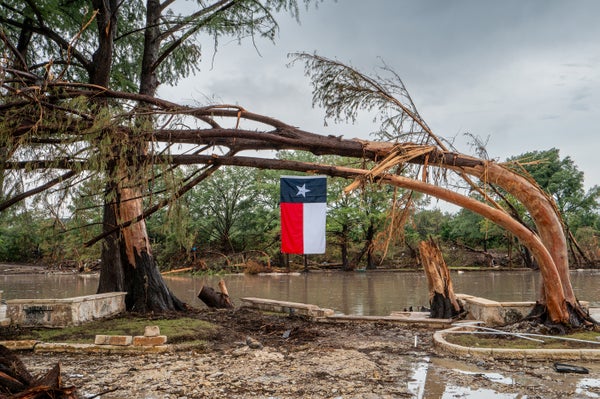
A Texas flag hangs from a storm-damaged tree on the banks of the Guadalupe River on July 13, 2025 in Center Point, TX. 132 people have been killed and more than 160 people are still missing after storm cells halted over the area, dumping nearly 15 inches of rain and causing a 22-foot rise along the Guadalupe River.
Brandon Bell/Getty Images
Thomas Frank covers the federal response to climate change for E&E News.
Mike Lee is a reporter for E&E News.
E&E News provides essential energy and environment news for professionals.
[enclosures] => Array ( ) [categories] => Array ( ) [uid] => [link] => https://www.scientificamerican.com/article/texas-failed-to-spend-federal-aid-for-flood-disaster-protection/ [description] =>Many states, including Texas, have not used billions of dollars from FEMA intended to reduce damage from flooding and other disasters
[pubDate] => Mon, 14 Jul 2025 20:30:00 +0000 [guid] => https://www.scientificamerican.com/article/texas-failed-to-spend-federal-aid-for-flood-disaster-protection/ ) [14] => Array ( [uri] => https://www.scientificamerican.com/podcast/episode/weight-stigma-persists-for-some-patients-after-bariatric-surgery/ [title] => Weight Stigma Persists for Some Patients after Bariatric Surgery [timestamp] => 1752357600 [author] => Rachel Feltman; Fonda Mwangi; Alex Sugiura [content] =>While bariatric surgery can result in significant weight loss, weight stigma can persist years after the surgery.
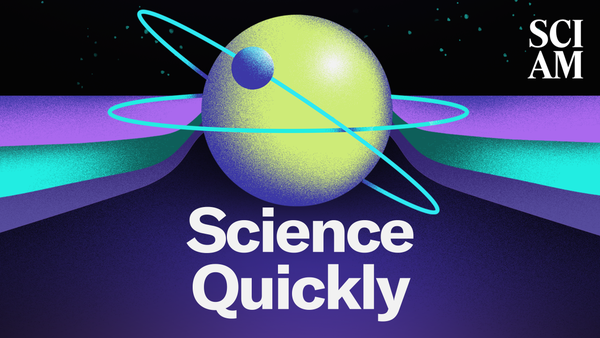
Anaissa Ruiz Tejada/Scientific American
Rachel Feltman is former executive editor of Popular Science and forever host of the podcast The Weirdest Thing I Learned This Week. She previously founded the blog Speaking of Science for the Washington Post.
Fonda Mwangi is a multimedia editor at Scientific American. She previously worked as an audio producer at Axios, The Recount and WTOP News. She holds a master’s degree in journalism and public affairs from American University in Washington, D.C.
Alex Sugiura is a Peabody and Pulitzer Prize–winning composer, editor and podcast producer based in Brooklyn, N.Y. He has worked on projects for Bloomberg, Axios, Crooked Media and Spotify, among others.
[enclosures] => Array ( ) [categories] => Array ( ) [uid] => [link] => https://www.scientificamerican.com/podcast/episode/weight-stigma-persists-for-some-patients-after-bariatric-surgery/ [description] =>While bariatric surgery can result in significant weight loss, weight stigma can persist years after the surgery.
[pubDate] => Mon, 14 Jul 2025 10:00:00 +0000 [guid] => https://www.scientificamerican.com/podcast/episode/weight-stigma-persists-for-some-patients-after-bariatric-surgery/ ) [15] => Array ( [uri] => https://www.scientificamerican.com/article/marjorie-taylor-greene-plans-hearing-on-geoengineering-amid-cloud-seeding/ [title] => Marjorie Taylor Greene Plans Hearing on Geoengineering amid Cloud Seeding Conspiracy Theories [timestamp] => 1752184800 [author] => Kevin Bogardus; E&E News [content] =>Republican Representative Marjorie Taylor Greene of Georgia has said she will hold a hearing on geoengineering as conspiracy theories have swirled around cloud seeding after the recent floods in Texas
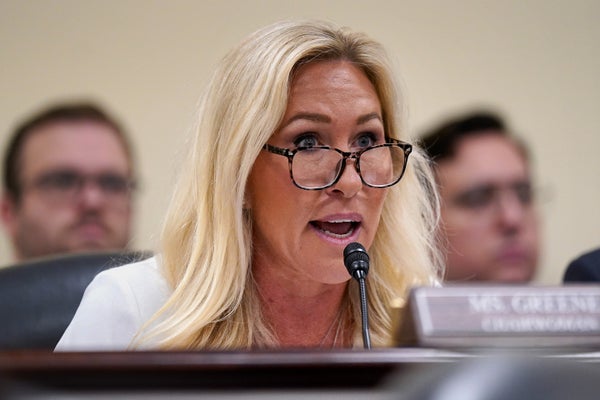
Chair of the Subcommittee on Delivering On Government Efficiency (DOGE) U.S. Rep. Marjorie Taylor Greene (R-SC) presides over a hearing of the House Oversight Subcommittee in the Rayburn House Office Building on February 12, 2025 in Washington, D.C.
Al Drago/Getty Images
Kevin Bogardus is a reporter at E&E News.
E&E News provides essential energy and environment news for professionals.
[enclosures] => Array ( ) [categories] => Array ( ) [uid] => [link] => https://www.scientificamerican.com/article/marjorie-taylor-greene-plans-hearing-on-geoengineering-amid-cloud-seeding/ [description] =>Republican Representative Marjorie Taylor Greene of Georgia has said she will hold a hearing on geoengineering as conspiracy theories have swirled around cloud seeding after the recent floods in Texas
[pubDate] => Fri, 11 Jul 2025 15:30:00 +0000 [guid] => https://www.scientificamerican.com/article/marjorie-taylor-greene-plans-hearing-on-geoengineering-amid-cloud-seeding/ ) [16] => Array ( [uri] => https://www.scientificamerican.com/article/waste-wars-tracks-the-wild-afterlife-of-garbage-on-an-international-black/ [title] => Waste Wars Tracks the ‘Wild Afterlife’ of Garbage on an International Black Market [timestamp] => 1752184800 [author] => Brianne Kane; Andrea Gawrylewski [content] =>Alexander Clapp, author of new nonfiction book Waste Wars, tracks the worldwide black market trade of our garbage
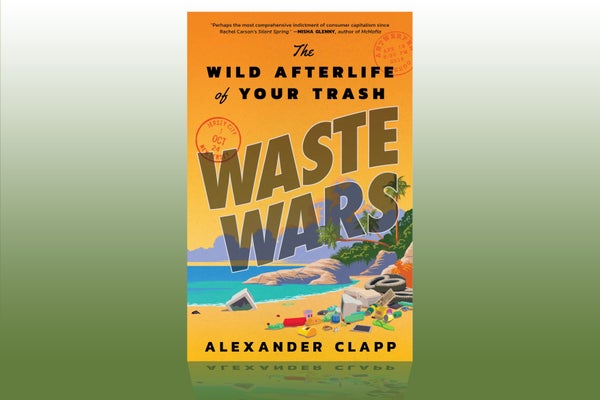
Brianne Kane is the editorial workflow and rights manager at Scientific American.
[enclosures] => Array ( ) [categories] => Array ( ) [uid] => [link] => https://www.scientificamerican.com/article/waste-wars-tracks-the-wild-afterlife-of-garbage-on-an-international-black/ [description] =>Alexander Clapp, author of new nonfiction book Waste Wars, tracks the worldwide black market trade of our garbage
[pubDate] => Fri, 11 Jul 2025 12:00:00 +0000 [guid] => https://www.scientificamerican.com/article/waste-wars-tracks-the-wild-afterlife-of-garbage-on-an-international-black/ ) [17] => Array ( [uri] => https://www.scientificamerican.com/article/were-light-years-away-from-true-artificial-intelligence-says-murderbot/ [title] => We’re Light-Years Away from True Artificial Intelligence, Says Murderbot Author Martha Wells [timestamp] => 1752184800 [author] => Clara Moskowitz; Allison Parshall [content] =>Today’s large language models are hardly related to the kinds of machine intelligence we see in science fiction, according to Martha Wells, author of the Murderbot Diaries series

Alexander Skarsgard in the Apple TV+ series Murderbot.
Album/Alamy Stock Photo
Clara Moskowitz is a senior editor at Scientific American, where she covers astronomy, space, physics and mathematics. She has been at Scientific American for a decade; previously she worked at Space.com. Moskowitz has reported live from rocket launches, space shuttle liftoffs and landings, suborbital spaceflight training, mountaintop observatories, and more. She has a bachelor's degree in astronomy and physics from Wesleyan University and a graduate degree in science communication from the University of California, Santa Cruz.
[enclosures] => Array ( ) [categories] => Array ( ) [uid] => [link] => https://www.scientificamerican.com/article/were-light-years-away-from-true-artificial-intelligence-says-murderbot/ [description] =>Today’s large language models are hardly related to the kinds of machine intelligence we see in science fiction, according to Martha Wells, author of the Murderbot Diaries series
[pubDate] => Fri, 11 Jul 2025 11:00:00 +0000 [guid] => https://www.scientificamerican.com/article/were-light-years-away-from-true-artificial-intelligence-says-murderbot/ ) [18] => Array ( [uri] => https://www.scientificamerican.com/article/chatgpt-is-changing-the-words-we-use-in-conversation/ [title] => ChatGPT Is Changing the Words We Use in Conversation [timestamp] => 1752184800 [author] => Vanessa Bates Ramirez; Allison Parshall [content] =>Words frequently used by ChatGPT, including “delve” and “meticulous,” are getting more common in spoken language, according to an analysis of more than 700,000 hours of videos and podcasts

Just_Super/Getty Images
Vanessa Bates Ramirez is a science and technology journalist focused on energy and climate tech, artificial intelligence and biotechnology. Her work has appeared in Time magazine, Forbes, AI Frontiers, Scientific American and SingularityHub, among other outlets. Follow Ramirez on X @vanessabramirez
[enclosures] => Array ( ) [categories] => Array ( ) [uid] => [link] => https://www.scientificamerican.com/article/chatgpt-is-changing-the-words-we-use-in-conversation/ [description] =>Words frequently used by ChatGPT, including “delve” and “meticulous,” are getting more common in spoken language, according to an analysis of more than 700,000 hours of videos and podcasts
[pubDate] => Fri, 11 Jul 2025 11:00:00 +0000 [guid] => https://www.scientificamerican.com/article/chatgpt-is-changing-the-words-we-use-in-conversation/ ) [19] => Array ( [uri] => https://www.scientificamerican.com/article/extreme-heat-endangers-ai-data-centers/ [title] => Extreme Heat Endangers AI Data Centers [timestamp] => 1752098400 [author] => Sara Schonhardt; E&E News [content] =>A new analysis warns that AI facilities could be forced to stop operating because of water shortages and blackouts
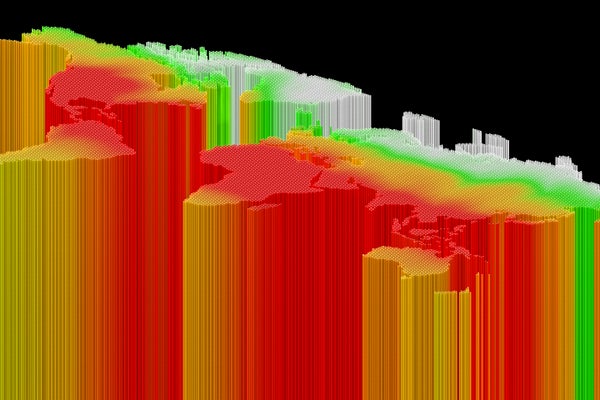
Christoph Burgstedt/Science Photo Library/Getty Images
Sara Schonhardt covers climate and energy developments globally, with a focus on international climate negotiations, finance and how countries are approaching the transition to cleaner economies. Prior to joining E&E News, Sara worked as a reporter for more than a decade across much of Southeast Asia, with stints for The New York Times, Christian Science Monitor and Voice of America. She was a staff reporter for The Wall Street Journal in Indonesia until 2017. Sara has a degree in journalism from Ohio University and a master's degree in international affairs from Columbia University.
E&E News provides essential energy and environment news for professionals.
[enclosures] => Array ( ) [categories] => Array ( ) [uid] => [link] => https://www.scientificamerican.com/article/extreme-heat-endangers-ai-data-centers/ [description] =>A new analysis warns that AI facilities could be forced to stop operating because of water shortages and blackouts
[pubDate] => Thu, 10 Jul 2025 16:00:00 +0000 [guid] => https://www.scientificamerican.com/article/extreme-heat-endangers-ai-data-centers/ ) [20] => Array ( [uri] => https://www.scientificamerican.com/article/four-new-autism-subtypes-link-genes-to-childrens-traits/ [title] => Four New Autism Subtypes Link Genes to Children's Traits [timestamp] => 1752098400 [author] => Allison Parshall; Jeanna Bryner [content] =>Autism has at least four subtypes, an analysis of more than 5,000 children’s genes, traits and developmental trajectories has shown
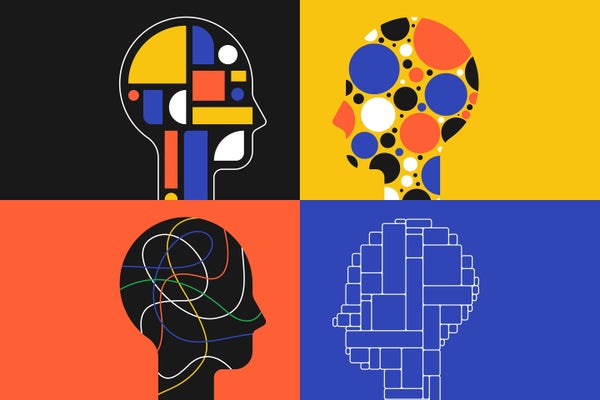
Muharrem Huner/Getty Images
Allison Parshall is an associate editor at Scientific American covering mind and brain. She writes the magazine's Contributors column and weekly online Science Quizzes. As a multimedia journalist, she contributes to Scientific American's podcast Science Quickly. Parshall's work has also appeared in Quanta Magazine and Inverse. She graduated from New York University's Arthur L. Carter Journalism Institute with a master's degree in science, health and environmental reporting. She has a bachelor's degree in psychology from Georgetown University.
[enclosures] => Array ( ) [categories] => Array ( ) [uid] => [link] => https://www.scientificamerican.com/article/four-new-autism-subtypes-link-genes-to-childrens-traits/ [description] =>Autism has at least four subtypes, an analysis of more than 5,000 children’s genes, traits and developmental trajectories has shown
[pubDate] => Thu, 10 Jul 2025 11:00:00 +0000 [guid] => https://www.scientificamerican.com/article/four-new-autism-subtypes-link-genes-to-childrens-traits/ ) [21] => Array ( [uri] => https://www.scientificamerican.com/article/attacks-on-higher-education-are-attacks-on-all-americans/ [title] => Attacks on Higher Education Are Attacks on All Americans [timestamp] => 1752098400 [author] => Matt Motta; Dominik Stecuła [content] =>If Americans don’t fight back against efforts to dismantle higher education, the U.S. will lose lifesaving medical research, innovation that spurs our economy and the ability to freely study science and society

The John W. Weeks Bridge at Harvard University in Cambridge, Massachusetts.
joe daniel price
Matt Motta is an assistant professor in the department of health law, policy, and management at the Boston University School of Public Health, and a faculty affiliate at the Center for Health Communication at the TH Chan School of Public Health at Harvard University. His research aims to assess the prevalence, causes and policy impact of antiscience attitudes, and to devise strategic communication campaigns aimed at improving trust in science.
Dominik Stecuła is an assistant professor of Communication and Political Science at The Ohio State University. His research focuses on political and science communication, and how the information environment shapes people’s beliefs.
[enclosures] => Array ( ) [categories] => Array ( ) [uid] => [link] => https://www.scientificamerican.com/article/attacks-on-higher-education-are-attacks-on-all-americans/ [description] =>If Americans don’t fight back against efforts to dismantle higher education, the U.S. will lose lifesaving medical research, innovation that spurs our economy and the ability to freely study science and society
[pubDate] => Thu, 10 Jul 2025 12:00:00 +0000 [guid] => https://www.scientificamerican.com/article/attacks-on-higher-education-are-attacks-on-all-americans/ ) [22] => Array ( [uri] => https://www.scientificamerican.com/article/can-ai-replace-air-traffic-controllers-to-reduce-airline-accidents/ [title] => Can AI Replace Air Traffic Controllers to Reduce Airline Accidents? [timestamp] => 1752098400 [author] => Adrienne Bernhard; Mark Fischetti [content] =>Tests in London and Singapore could reveal whether AI can improve the safety of air travel

Airbus A340 at Heathrow airport.
stonefaction photography/Getty Images
Adrienne Bernhard is a journalist whose work appears in BBC Future, Popular Mechanics, the Atlantic, the Economist, Foreign Policy and the Wall Street Journal. She writes about technology, the environment, culture and mathematics.
[enclosures] => Array ( ) [categories] => Array ( ) [uid] => [link] => https://www.scientificamerican.com/article/can-ai-replace-air-traffic-controllers-to-reduce-airline-accidents/ [description] =>Tests in London and Singapore could reveal whether AI can improve the safety of air travel
[pubDate] => Thu, 10 Jul 2025 14:00:00 +0000 [guid] => https://www.scientificamerican.com/article/can-ai-replace-air-traffic-controllers-to-reduce-airline-accidents/ ) [23] => Array ( [uri] => https://www.scientificamerican.com/article/ancient-tooth-proteins-rewrite-the-rhino-family-tree-are-dinosaurs-next/ [title] => Ancient Tooth Proteins Rewrite the Rhino Family Tree—Are Dinosaurs Next? [timestamp] => 1752098400 [author] => Ewen Callaway; Nature magazine [content] =>Molecules from the 20-million-year-old teeth of a rhino relative are among the oldest ever sequenced, opening tantalizing possibilities to scientists
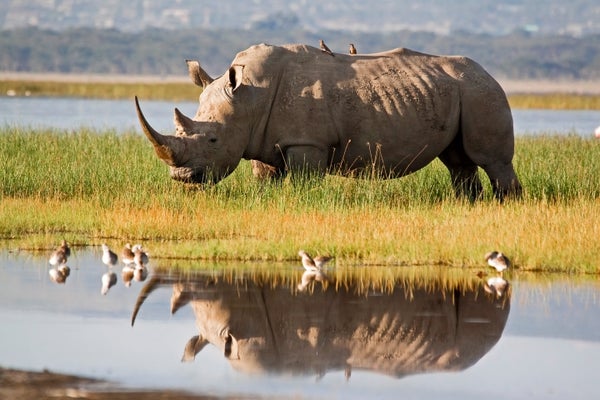
Rhinos’ evolutionary relationships became a little clearer with the sequencing of the oldest proteins yet.
WLDavies/Getty Images
Ewen Callaway is a senior reporter at Nature.
First published in 1869, Nature is the world's leading multidisciplinary science journal. Nature publishes the finest peer-reviewed research that drives ground-breaking discovery, and is read by thought-leaders and decision-makers around the world.
[enclosures] => Array ( ) [categories] => Array ( ) [uid] => [link] => https://www.scientificamerican.com/article/ancient-tooth-proteins-rewrite-the-rhino-family-tree-are-dinosaurs-next/ [description] =>Molecules from the 20-million-year-old teeth of a rhino relative are among the oldest ever sequenced, opening tantalizing possibilities to scientists
[pubDate] => Thu, 10 Jul 2025 15:00:00 +0000 [guid] => https://www.scientificamerican.com/article/ancient-tooth-proteins-rewrite-the-rhino-family-tree-are-dinosaurs-next/ ) [24] => Array ( [uri] => https://www.scientificamerican.com/article/nanoplastics-make-up-most-of-the-oceans-plastic-pollution/ [title] => Nanoplastics Make Up Most of the Ocean’s Plastic Pollution [timestamp] => 1752098400 [author] => Katharine Sanderson; Nature magazine [content] =>Nanoplastics—particles smaller than a human hair—can pass through cell walls and enter the food web. New research suggest 27 million metric tons of nanoplastics are spread across just the top layer of the North Atlantic
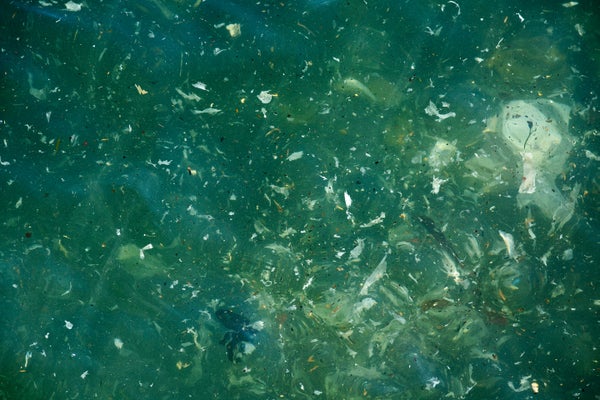
Sergi Escribano/Getty Images
Katharine Sanderson is a freelance journalist based in Cornwall, UK.
First published in 1869, Nature is the world's leading multidisciplinary science journal. Nature publishes the finest peer-reviewed research that drives ground-breaking discovery, and is read by thought-leaders and decision-makers around the world.
[enclosures] => Array ( ) [categories] => Array ( ) [uid] => [link] => https://www.scientificamerican.com/article/nanoplastics-make-up-most-of-the-oceans-plastic-pollution/ [description] =>Nanoplastics—particles smaller than a human hair—can pass through cell walls and enter the food web. New research suggest 27 million metric tons of nanoplastics are spread across just the top layer of the North Atlantic
[pubDate] => Thu, 10 Jul 2025 16:30:00 +0000 [guid] => https://www.scientificamerican.com/article/nanoplastics-make-up-most-of-the-oceans-plastic-pollution/ ) [25] => Array ( [uri] => https://www.scientificamerican.com/podcast/episode/how-and-why-humans-began-to-sing-a-musicology-and-neuroscience-perspective/ [title] => How and Why Humans Began to Sing, a Musicology and Neuroscience Perspective [timestamp] => 1752098400 [author] => Rachel Feltman; Allison Parshall; Fonda Mwangi; Madison Goldberg [content] =>Musicologists and neuroscientists have been trying to understand what turns speech into music.
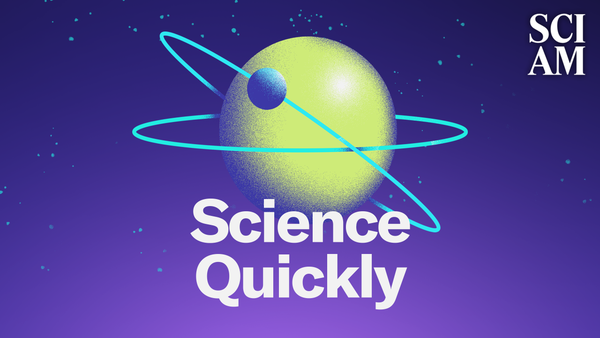
Anaissa Ruiz Tejada/Scientific American
Rachel Feltman is former executive editor of Popular Science and forever host of the podcast The Weirdest Thing I Learned This Week. She previously founded the blog Speaking of Science for the Washington Post.
Allison Parshall is an associate editor at Scientific American covering mind and brain. She writes the magazine's Contributors column and weekly online Science Quizzes. As a multimedia journalist, she contributes to Scientific American's podcast Science Quickly. Parshall's work has also appeared in Quanta Magazine and Inverse. She graduated from New York University's Arthur L. Carter Journalism Institute with a master's degree in science, health and environmental reporting. She has a bachelor's degree in psychology from Georgetown University.
Fonda Mwangi is a multimedia editor at Scientific American. She previously worked as an audio producer at Axios, The Recount and WTOP News. She holds a master’s degree in journalism and public affairs from American University in Washington, D.C.
Madison Goldberg is a science journalist and audio producer based in New York City. She holds a bachelor's degree in Earth and Planetary Sciences from Harvard University and a master's degree from New York University's Science, Health and Environmental Reporting Program. Her work has also appeared in Quanta Magazine, the NPR project StateImpact Pennsylvania and elsewhere.
[enclosures] => Array ( ) [categories] => Array ( ) [uid] => [link] => https://www.scientificamerican.com/podcast/episode/how-and-why-humans-began-to-sing-a-musicology-and-neuroscience-perspective/ [description] =>Musicologists and neuroscientists have been trying to understand what turns speech into music.
[pubDate] => Fri, 11 Jul 2025 10:00:00 +0000 [guid] => https://www.scientificamerican.com/podcast/episode/how-and-why-humans-began-to-sing-a-musicology-and-neuroscience-perspective/ ) [26] => Array ( [uri] => https://www.scientificamerican.com/article/water-on-mars-probably-doesnt-explain-these-weird-streaks/ [title] => Water on Mars Probably Doesn’t Explain These Weird Streaks [timestamp] => 1752098400 [author] => Phil Plait; Lee Billings [content] =>A new global overview of Mars suggests dust, rather than water, is the source of mysterious streaks there
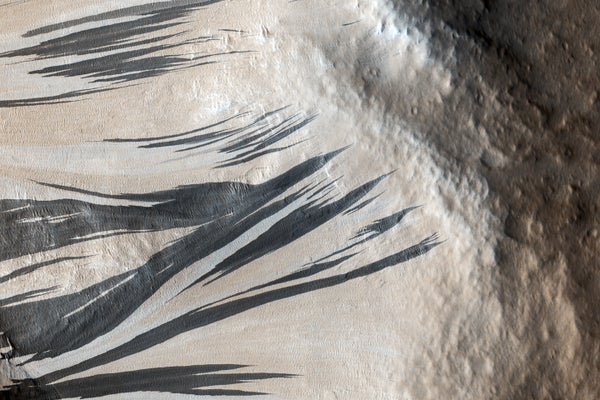
Dark “slope streaks,” likely resulting from dust avalanches, stretch across an area of Mars called Acheron Fossae in this image from the High-Resolution Imaging Science Experiment (HiRISE) camera aboard NASA’s Mars Reconnaissance Orbiter.
NASA/JPL-Caltech/University of Arizona
Phil Plait is a professional astronomer and science communicator in Virginia. His column for Scientific American, The Universe, covers all things space. He writes the Bad Astronomy Newsletter. Follow him online.
[enclosures] => Array ( ) [categories] => Array ( ) [uid] => [link] => https://www.scientificamerican.com/article/water-on-mars-probably-doesnt-explain-these-weird-streaks/ [description] =>A new global overview of Mars suggests dust, rather than water, is the source of mysterious streaks there
[pubDate] => Fri, 11 Jul 2025 10:45:00 +0000 [guid] => https://www.scientificamerican.com/article/water-on-mars-probably-doesnt-explain-these-weird-streaks/ ) [27] => Array ( [uri] => https://www.scientificamerican.com/article/elon-musks-new-grok-4-takes-on-humanitys-last-exam-as-the-ai-race-heats-up/ [title] => Elon Musk's New Grok 4 Takes on ‘Humanity’s Last Exam’ as the AI Race Heats Up [timestamp] => 1752098400 [author] => Deni Ellis Béchard; Dean Visser [content] =>Elon Musk has launched xAI’s Grok 4—calling it the “world’s smartest AI” and claiming it can ace Ph.D.-level exams and outpace rivals such as Google’s Gemini and OpenAI’s o3 on tough benchmarks

Floriana/Getty Images
Deni Ellis Béchard is Scientific American’s senior tech reporter. He is author of 10 books and has received a Commonwealth Writers’ Prize, a Midwest Book Award and a Nautilus Book Award for investigative journalism. He holds two master’s degrees in literature, as well as a master’s degree in biology from Harvard University. His most recent novel, We Are Dreams in the Eternal Machine, explores the ways that artificial intelligence could transform humanity. You can follow him on X, Instagram and Bluesky @denibechard.
[enclosures] => Array ( ) [categories] => Array ( ) [uid] => [link] => https://www.scientificamerican.com/article/elon-musks-new-grok-4-takes-on-humanitys-last-exam-as-the-ai-race-heats-up/ [description] =>Elon Musk has launched xAI’s Grok 4—calling it the “world’s smartest AI” and claiming it can ace Ph.D.-level exams and outpace rivals such as Google’s Gemini and OpenAI’s o3 on tough benchmarks
[pubDate] => Fri, 11 Jul 2025 18:30:00 +0000 [guid] => https://www.scientificamerican.com/article/elon-musks-new-grok-4-takes-on-humanitys-last-exam-as-the-ai-race-heats-up/ ) [28] => Array ( [uri] => https://www.scientificamerican.com/article/trump-names-transportation-secretary-sean-duffy-as-interim-nasa-chief/ [title] => Trump Names Transportation Secretary Sean Duffy as Interim NASA Chief [timestamp] => 1752098400 [author] => Josh Dinner; SPACE.com [content] =>The selection of Secretary of Transportation Sean Duffy to temporarily lead NASA adds to the deep political uncertainties already facing the space agency

Sean Duffy, U.S. secretary of transportation, during a news conference in Washington, D.C., on June 12, 2025.
Eric Lee/Bloomberg via Getty Images
Josh Dinner is Space.com's content manager. He is also a freelance writer, photographer and videographer covering space exploration, human spaceflight and other subjects. He has covered everything from rocket launches and NASA's Artemis 1 Space Launch System megarocket to SpaceX astronaut launches for NASA.
SPACE.com is the premier source of space exploration, innovation and astronomy news, chronicling (and celebrating) humanity's ongoing expansion across the final frontier.
[enclosures] => Array ( ) [categories] => Array ( ) [uid] => [link] => https://www.scientificamerican.com/article/trump-names-transportation-secretary-sean-duffy-as-interim-nasa-chief/ [description] =>The selection of Secretary of Transportation Sean Duffy to temporarily lead NASA adds to the deep political uncertainties already facing the space agency
[pubDate] => Thu, 10 Jul 2025 16:45:00 +0000 [guid] => https://www.scientificamerican.com/article/trump-names-transportation-secretary-sean-duffy-as-interim-nasa-chief/ ) [29] => Array ( [uri] => https://www.scientificamerican.com/article/science-fair-of-lost-research-protests-trump-cuts/ [title] => ‘Science Fair’ of Lost Research Protests Trump Cuts [timestamp] => 1752012000 [author] => Jenna Ahart; Nature magazine [content] =>A protest at a congressional office building highlighted future research findings that vast cuts to science will erase

Dkfielding/Getty Images
Jenna Ahart is a science journalist specializing in the physical sciences.
First published in 1869, Nature is the world's leading multidisciplinary science journal. Nature publishes the finest peer-reviewed research that drives ground-breaking discovery, and is read by thought-leaders and decision-makers around the world.
[enclosures] => Array ( ) [categories] => Array ( ) [uid] => [link] => https://www.scientificamerican.com/article/science-fair-of-lost-research-protests-trump-cuts/ [description] =>A protest at a congressional office building highlighted future research findings that vast cuts to science will erase
[pubDate] => Wed, 09 Jul 2025 21:00:00 +0000 [guid] => https://www.scientificamerican.com/article/science-fair-of-lost-research-protests-trump-cuts/ ) [30] => Array ( [uri] => https://www.scientificamerican.com/article/texas-floods-were-a-known-risk-but-little-has-been-done-for-protection/ [title] => Texas Floods Were a Known Risk, but Little Has Been Done for Protection [timestamp] => 1752012000 [author] => Mike Lee; Thomas Frank; Chelsea Harvey; E&E News [content] =>Texas has identified more than $50 billion in flood control needs, but lawmakers have devoted just $1.4 billion to address them
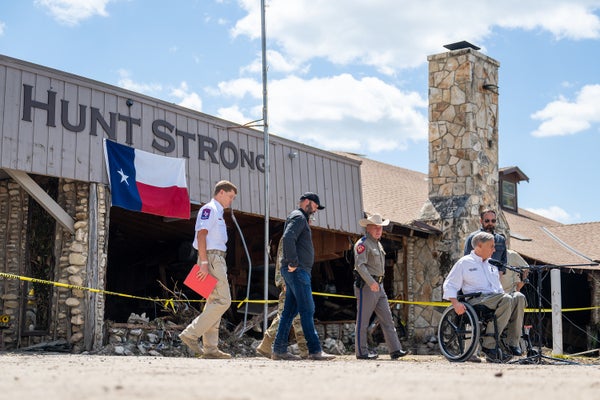
Gov. Greg Abbott arrives at a news conference on July 08, 2025 in Hunt, Texas. Gov. Abbott announced that more than 160 people are still missing after deadly floods early Friday. Last week, heavy rainfall caused severe flash flooding along the Guadalupe River in central Texas, leaving more than 100 people reported dead, including children attending Camp Mystic.
Brandon Bell/Getty Images
Mike Lee is a reporter for E&E News.
Thomas Frank covers the federal response to climate change for E&E News.
Chelsea Harvey covers climate science for Climatewire. She tracks the big questions being asked by researchers and explains what's known, and what needs to be, about global temperatures. Chelsea began writing about climate science in 2014. Her work has appeared in The Washington Post, Popular Science, Men's Journal and others.
E&E News provides essential energy and environment news for professionals.
[enclosures] => Array ( ) [categories] => Array ( ) [uid] => [link] => https://www.scientificamerican.com/article/texas-floods-were-a-known-risk-but-little-has-been-done-for-protection/ [description] =>Texas has identified more than $50 billion in flood control needs, but lawmakers have devoted just $1.4 billion to address them
[pubDate] => Wed, 09 Jul 2025 16:00:00 +0000 [guid] => https://www.scientificamerican.com/article/texas-floods-were-a-known-risk-but-little-has-been-done-for-protection/ ) [31] => Array ( [uri] => https://www.scientificamerican.com/article/japans-new-undersea-earthquake-detection-system-will-improve-tsunami/ [title] => Japan’s New Undersea Earthquake Detection System Will Improve Tsunami Prediction [timestamp] => 1752012000 [author] => Deni Ellis Béchard; Dean Visser [content] =>Japan’s new earthquake-detection network lengthens warning times, and researchers in Wales have harnessed nuclear blast detectors to gauge tsunami risks. But the U.S. lags in monitoring the massive Cascadia megathrust fault
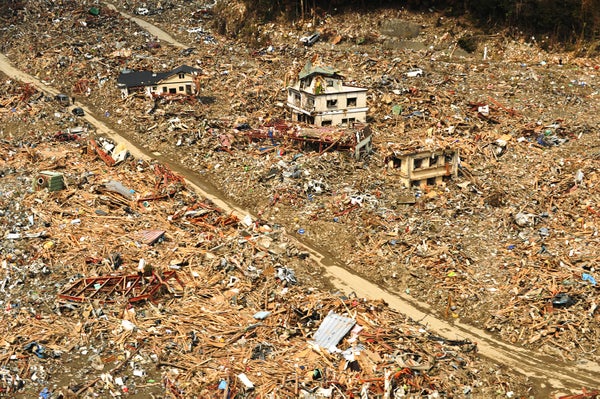
Aerial view of the devastated along the north eastern coast of Japan following a massive earthquake and tsunami March 25, 2011.
DOD Photo/Alamy Stock Photo
Deni Ellis Béchard is Scientific American’s senior tech reporter. He is author of 10 books and has received a Commonwealth Writers’ Prize, a Midwest Book Award and a Nautilus Book Award for investigative journalism. He holds two master’s degrees in literature, as well as a master’s degree in biology from Harvard University. His most recent novel, We Are Dreams in the Eternal Machine, explores the ways that artificial intelligence could transform humanity. You can follow him on X, Instagram and Bluesky @denibechard.
[enclosures] => Array ( ) [categories] => Array ( ) [uid] => [link] => https://www.scientificamerican.com/article/japans-new-undersea-earthquake-detection-system-will-improve-tsunami/ [description] =>Japan’s new earthquake-detection network lengthens warning times, and researchers in Wales have harnessed nuclear blast detectors to gauge tsunami risks. But the U.S. lags in monitoring the massive Cascadia megathrust fault
[pubDate] => Wed, 09 Jul 2025 15:15:00 +0000 [guid] => https://www.scientificamerican.com/article/japans-new-undersea-earthquake-detection-system-will-improve-tsunami/ ) [32] => Array ( [uri] => https://www.scientificamerican.com/article/chatgpt-and-gemini-ai-have-uniquely-different-writing-styles/ [title] => ChatGPT and Gemini AIs Have Uniquely Different Writing Styles [timestamp] => 1752012000 [author] => Karolina Rudnicka; Madhusree Mukerjee [content] =>ChatGPT and Gemini AI write in different idioms, linguists find

Miakievy/Getty Images
Karolina Rudnicka is a linguist at the University of Gdańsk in Poland. She researches language variation and change, especially under the influence of new technologies and across time.
[enclosures] => Array ( ) [categories] => Array ( ) [uid] => [link] => https://www.scientificamerican.com/article/chatgpt-and-gemini-ai-have-uniquely-different-writing-styles/ [description] =>ChatGPT and Gemini AI write in different idioms, linguists find
[pubDate] => Wed, 09 Jul 2025 12:00:00 +0000 [guid] => https://www.scientificamerican.com/article/chatgpt-and-gemini-ai-have-uniquely-different-writing-styles/ ) [33] => Array ( [uri] => https://www.scientificamerican.com/article/science-makes-the-u-s-a-great-nation/ [title] => Science Makes the U.S. a Great Nation [timestamp] => 1751925600 [author] => Paul M. Sutter [content] =>History tells us what happens when great nations attack science
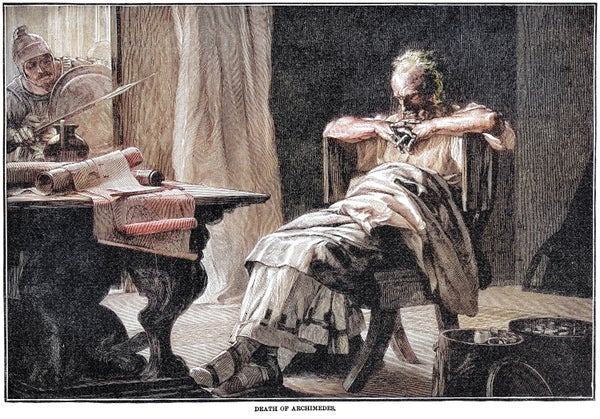
Engraving of the death of Archimedes.
mikroman6
Paul M. Sutter is a cosmologist at Johns Hopkins University, as well as an author, television host and U.S. cultural ambassador.
[enclosures] => Array ( ) [categories] => Array ( ) [uid] => [link] => https://www.scientificamerican.com/article/science-makes-the-u-s-a-great-nation/ [description] =>History tells us what happens when great nations attack science
[pubDate] => Tue, 08 Jul 2025 14:00:00 +0000 [guid] => https://www.scientificamerican.com/article/science-makes-the-u-s-a-great-nation/ ) [34] => Array ( [uri] => https://www.scientificamerican.com/article/cutting-edge-physics-and-chemistry-now-unfold-one-attosecond-at-a-time/ [title] => Cutting-Edge Physics and Chemistry Now Unfold One Attosecond at a Time [timestamp] => 1751925600 [author] => Ivan Amato; Knowable Magazine [content] =>An attosecond—or 0.000000000000000001 second—is no time at all for a person. That is not so for electrons, atoms and molecules, and laser-wielding scientists are revealing the action

Sergei Krestinin/Getty Images
Ivan Amato is a science and technology writer, editor, communicator, podcaster, public-engagement professional and crystal photomicrographer.
[enclosures] => Array ( ) [categories] => Array ( ) [uid] => [link] => https://www.scientificamerican.com/article/cutting-edge-physics-and-chemistry-now-unfold-one-attosecond-at-a-time/ [description] =>An attosecond—or 0.000000000000000001 second—is no time at all for a person. That is not so for electrons, atoms and molecules, and laser-wielding scientists are revealing the action
[pubDate] => Tue, 08 Jul 2025 12:00:00 +0000 [guid] => https://www.scientificamerican.com/article/cutting-edge-physics-and-chemistry-now-unfold-one-attosecond-at-a-time/ ) [35] => Array ( [uri] => https://www.scientificamerican.com/article/flood-forecasts-in-texas-and-beyond-could-worsen-with-trump-nws-cuts/ [title] => Flood Forecasts in Texas and Beyond Could Worsen with Trump NWS Cuts [timestamp] => 1751925600 [author] => Scott Waldman; Chelsea Harvey; E&E News [content] =>Forecasts and warnings largely worked during the recent flooding catastrophe in Texas. Those systems are expected to degrade as President Donald Trump’s cuts to the National Weather Service, satellites and other key services take hold
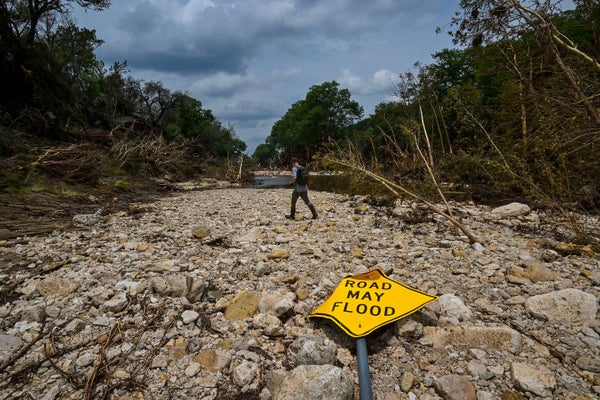
Search and rescue personnel continue to look for missing people along the Guadalupe River on July 7, 2025 in Hunt, Texas. As of July 8, at least 108 people have died in the Central Texas floods, including 28 children, and dozens of people are still unaccounted for due to the quick moving flash flood.
Joshua Lott/The Washington Post via Getty Images
Scott Waldman is a reporter for E&E News.
Chelsea Harvey covers climate science for Climatewire. She tracks the big questions being asked by researchers and explains what's known, and what needs to be, about global temperatures. Chelsea began writing about climate science in 2014. Her work has appeared in The Washington Post, Popular Science, Men's Journal and others.
E&E News provides essential energy and environment news for professionals.
[enclosures] => Array ( ) [categories] => Array ( ) [uid] => [link] => https://www.scientificamerican.com/article/flood-forecasts-in-texas-and-beyond-could-worsen-with-trump-nws-cuts/ [description] =>Forecasts and warnings largely worked during the recent flooding catastrophe in Texas. Those systems are expected to degrade as President Donald Trump’s cuts to the National Weather Service, satellites and other key services take hold
[pubDate] => Tue, 08 Jul 2025 16:30:00 +0000 [guid] => https://www.scientificamerican.com/article/flood-forecasts-in-texas-and-beyond-could-worsen-with-trump-nws-cuts/ ) [36] => Array ( [uri] => https://www.scientificamerican.com/podcast/episode/tracking-coral-reef-health-with-bioacoustics/ [title] => Tracking Coral Reef Health with Bioacoustics [timestamp] => 1751925600 [author] => Rachel Feltman; Fonda Mwangi; Jeffery DelViscio [content] =>The underwater world relies on sound signals—so what happens when a noisy reef falls silent?
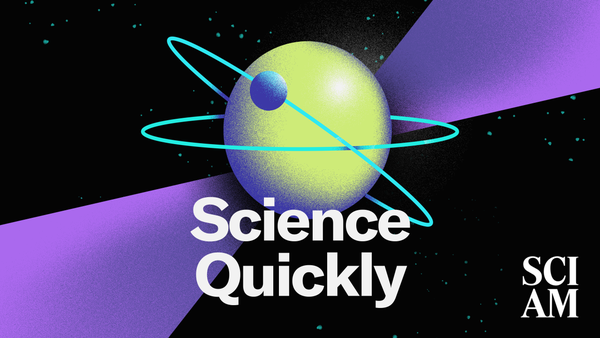
Anaissa Ruiz Tejada/Scientific American
Rachel Feltman is former executive editor of Popular Science and forever host of the podcast The Weirdest Thing I Learned This Week. She previously founded the blog Speaking of Science for the Washington Post.
Fonda Mwangi is a multimedia editor at Scientific American. She previously worked as an audio producer at Axios, The Recount and WTOP News. She holds a master’s degree in journalism and public affairs from American University in Washington, D.C.
Jeffery DelViscio is currently chief multimedia editor/executive producer at Scientific American. He is former director of multimedia at STAT, where he oversaw all visual, audio and interactive journalism. Before that he spent more than eight years at the New York Times, where he worked on five different desks across the paper. He holds dual master's degrees in journalism and in Earth and environmental sciences from Columbia University. He has worked onboard oceanographic research vessels and tracked money and politics in science from Washington, D.C. He was a Knight Science Journalism Fellow at the Massachusetts Institute of Technology in 2018. His work has won numerous awards, including two News and Documentary Emmy Awards.
[enclosures] => Array ( ) [categories] => Array ( ) [uid] => [link] => https://www.scientificamerican.com/podcast/episode/tracking-coral-reef-health-with-bioacoustics/ [description] =>The underwater world relies on sound signals—so what happens when a noisy reef falls silent?
[pubDate] => Wed, 09 Jul 2025 10:00:00 +0000 [guid] => https://www.scientificamerican.com/podcast/episode/tracking-coral-reef-health-with-bioacoustics/ ) [37] => Array ( [uri] => https://www.scientificamerican.com/article/gut-microbe-deficiency-in-u-s-babies-tied-to-asthma-allergies-autoimmune/ [title] => Gut Microbe Deficiency in U.S. Babies Tied to Asthma, Allergies, Autoimmune Disorders [timestamp] => 1751839200 [author] => Rachel Nuwer; Andrea Gawrylewski [content] =>Babies lacking in key gut bacteria are at greater risk of developing asthma, allergies or eczema

Evgeniia Siiankovskaia/Getty Images
Rachel Nuwer is a science journalist and author. Her latest book is I Feel Love: MDMA and the Quest for Connection in a Fractured World (Bloomsbury, 2023). Follow her on X @RachelNuwer
[enclosures] => Array ( ) [categories] => Array ( ) [uid] => [link] => https://www.scientificamerican.com/article/gut-microbe-deficiency-in-u-s-babies-tied-to-asthma-allergies-autoimmune/ [description] =>Babies lacking in key gut bacteria are at greater risk of developing asthma, allergies or eczema
[pubDate] => Tue, 08 Jul 2025 17:30:00 +0000 [guid] => https://www.scientificamerican.com/article/gut-microbe-deficiency-in-u-s-babies-tied-to-asthma-allergies-autoimmune/ ) [38] => Array ( [uri] => https://www.scientificamerican.com/article/why-texas-flash-flood-alley-is-so-deadly-explained-by-geology/ [title] => Why Texas ‘Flash Flood Alley’ Is So Deadly, Explained by Geology [timestamp] => 1751839200 [author] => Hatim Sharif; The Conversation US [content] =>A hydrologist explains why Texas Hill Country is known as Flash Flood Alley and how its geography and geology can lead to heavy downpours and sudden, destructive floods
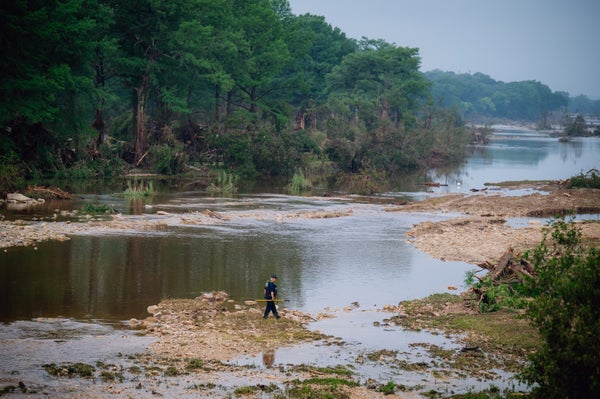
A man conducts a search near the Guadalupe River in Kerrville, Texas on Sunday, July 6, 2025. Devastating floods swept through Central Texas on Thursday evening and Friday morning, raising the death toll to 51 and countless more who remain missing, including 27 girls from Camp Mystic.
Desiree Rios for The Washington Post via Getty Images
Hatim Sharif is a professor of civil and environmental engineering at the University of Texas at San Antonio.
Curated by professional editors, The Conversation offers informed commentary and debate on the issues affecting our world.
[enclosures] => Array ( ) [categories] => Array ( ) [uid] => [link] => https://www.scientificamerican.com/article/why-texas-flash-flood-alley-is-so-deadly-explained-by-geology/ [description] =>A hydrologist explains why Texas Hill Country is known as Flash Flood Alley and how its geography and geology can lead to heavy downpours and sudden, destructive floods
[pubDate] => Mon, 07 Jul 2025 20:40:00 +0000 [guid] => https://www.scientificamerican.com/article/why-texas-flash-flood-alley-is-so-deadly-explained-by-geology/ ) [39] => Array ( [uri] => https://www.scientificamerican.com/article/the-benefits-of-raising-conscientious-kids/ [title] => The Benefits of Raising Conscientious Kids [timestamp] => 1751839200 [author] => Jasmine Mote; Megha Satyanarayana [content] =>Being conscientious will serve kids in the long run. Here are some tips to help them learn that trait

Boris Zhitkov/Alamy Stock Photo
Jasmine Mote is a licensed clinical psychologist and research assistant professor at Sargent College of Health and Rehabilitation Sciences at Boston University. She received her Ph.D. from the University of California, Berkeley. She also writes Mental Healthy, a newsletter on mental health science on pregnancy, parenting and everything in between. You can follow her on Bluesky @jmote.bsky.social.
[enclosures] => Array ( ) [categories] => Array ( ) [uid] => [link] => https://www.scientificamerican.com/article/the-benefits-of-raising-conscientious-kids/ [description] =>Being conscientious will serve kids in the long run. Here are some tips to help them learn that trait
[pubDate] => Mon, 07 Jul 2025 20:00:00 +0000 [guid] => https://www.scientificamerican.com/article/the-benefits-of-raising-conscientious-kids/ ) [40] => Array ( [uri] => https://www.scientificamerican.com/article/why-did-texas-flash-flood-waters-rise-so-quickly/ [title] => Why Did Texas Flash Flood Waters Rise So Quickly? [timestamp] => 1751839200 [author] => Andrea Thompson; Jeanna Bryner [content] =>Flash floods happen when heavy rains unleash more water than the ground can absorb, causing that water to pile up and flow to low-lying areas
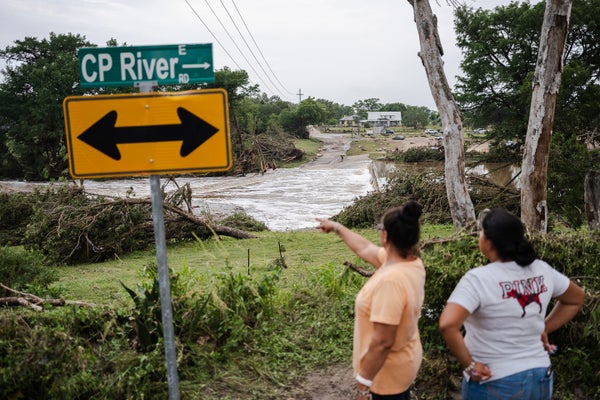
Two women survey the damage caused by flash flooding on the bank Guadalupe River in Center Point, Tex., on July 5, 2025. Heavy rainfall caused flooding along the Guadalupe River in central Texas, with multiple fatalities reported.
Jim Vondruska/Getty Images
Andrea Thompson is an associate editor covering the environment, energy and earth sciences. She has been covering these issues for 16 years. Prior to joining Scientific American, she was a senior writer covering climate science at Climate Central and a reporter and editor at Live Science, where she primarily covered earth science and the environment. She has moderated panels, including as part of the United Nations Sustainable Development Media Zone, and appeared in radio and television interviews on major networks. She holds a graduate degree in science, health and environmental reporting from New York University, as well as a B.S. and an M.S. in atmospheric chemistry from the Georgia Institute of Technology. Follow Thompson on Bluesky @andreatweather.bsky.social
[enclosures] => Array ( ) [categories] => Array ( ) [uid] => [link] => https://www.scientificamerican.com/article/why-did-texas-flash-flood-waters-rise-so-quickly/ [description] =>Flash floods happen when heavy rains unleash more water than the ground can absorb, causing that water to pile up and flow to low-lying areas
[pubDate] => Mon, 07 Jul 2025 16:00:00 +0000 [guid] => https://www.scientificamerican.com/article/why-did-texas-flash-flood-waters-rise-so-quickly/ ) [41] => Array ( [uri] => https://www.scientificamerican.com/article/addiction-risk-shows-up-in-childrens-brain-scans-before-drug-use-starts/ [title] => Addiction Risk Shows up in Children’s Brain Scans before Drug Use Starts [timestamp] => 1751839200 [author] => Maia Szalavitz; Allison Parshall [content] =>Brain differences in children and teens who experiment with drugs early show up before they take their first puff or sip

Mehau Kulyk/Science Photo Library/Getty Images
Maia Szalavitz is the author of, most recently, Undoing Drugs: How Harm Reduction Is Changing the Future of Drugs and Addiction (Hachette Books, 2021). She is a contributing opinion writer for the New York Times and author or co-author of seven other books.
[enclosures] => Array ( ) [categories] => Array ( ) [uid] => [link] => https://www.scientificamerican.com/article/addiction-risk-shows-up-in-childrens-brain-scans-before-drug-use-starts/ [description] =>Brain differences in children and teens who experiment with drugs early show up before they take their first puff or sip
[pubDate] => Mon, 07 Jul 2025 15:15:00 +0000 [guid] => https://www.scientificamerican.com/article/addiction-risk-shows-up-in-childrens-brain-scans-before-drug-use-starts/ ) [42] => Array ( [uri] => https://www.scientificamerican.com/article/texas-flood-forecasts-were-accurate/ [title] => Texas Flood Forecasts Were Accurate but Not Sufficient to Save Lives [timestamp] => 1751839200 [author] => Chelsea Harvey; E&E News [content] =>The National Weather Service issued timely alerts, meteorologists say, but few were listening in the hours before the early-morning flash floods along the Guadalupe River
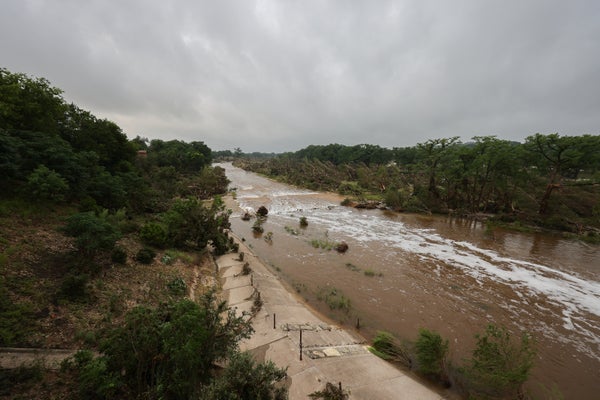
Widespread damage is visible in and around Kerrville, Texas, on July 6, 2025, following a deadly flash flood that caused the Guadalupe River to rise 26 feet in less than an hour.
Reginald Mathalone/NurPhoto via Getty Images
Chelsea Harvey covers climate science for Climatewire. She tracks the big questions being asked by researchers and explains what's known, and what needs to be, about global temperatures. Chelsea began writing about climate science in 2014. Her work has appeared in The Washington Post, Popular Science, Men's Journal and others.
E&E News provides essential energy and environment news for professionals.
[enclosures] => Array ( ) [categories] => Array ( ) [uid] => [link] => https://www.scientificamerican.com/article/texas-flood-forecasts-were-accurate/ [description] =>The National Weather Service issued timely alerts, meteorologists say, but few were listening in the hours before the early-morning flash floods along the Guadalupe River
[pubDate] => Mon, 07 Jul 2025 15:00:00 +0000 [guid] => https://www.scientificamerican.com/article/texas-flood-forecasts-were-accurate/ ) [43] => Array ( [uri] => https://www.scientificamerican.com/article/pulsing-magma-in-earths-mantle-drives-tectonic-plates-tearing-africa-apart/ [title] => Pulsing Magma in Earth’s Mantle Drives Tectonic Plates Tearing Africa Apart [timestamp] => 1751839200 [author] => Nora Bradford; Andrea Thompson [content] =>Chemical fingerprints from volcanic rock offer hints of what’s happening in the mantle below the area where three rift zones meet in East Africa
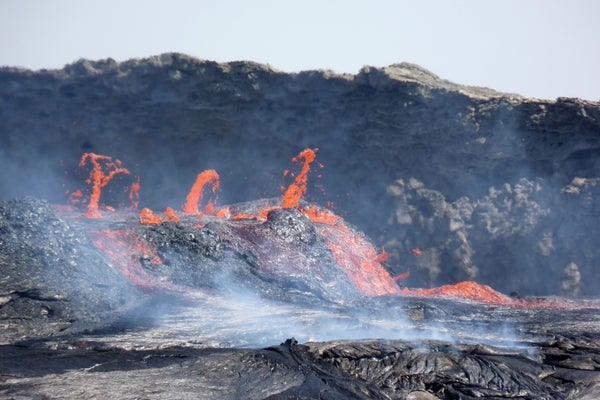
Active lava flows spilling out of the Erta Ale volcano in Afar, Ethiopia.
Dr. Derek Keir, University of Southampton/University of Florence
Nora Bradford is the current news intern at Scientific American, a freelance science writer and a Ph.D. student in cognitive science. Follow Bradford on Blusky @norabradford.bsky.social
[enclosures] => Array ( ) [categories] => Array ( ) [uid] => [link] => https://www.scientificamerican.com/article/pulsing-magma-in-earths-mantle-drives-tectonic-plates-tearing-africa-apart/ [description] =>Chemical fingerprints from volcanic rock offer hints of what’s happening in the mantle below the area where three rift zones meet in East Africa
[pubDate] => Mon, 07 Jul 2025 10:30:00 +0000 [guid] => https://www.scientificamerican.com/article/pulsing-magma-in-earths-mantle-drives-tectonic-plates-tearing-africa-apart/ ) [44] => Array ( [uri] => https://www.scientificamerican.com/podcast/episode/astronaut-matthew-dominick-speaks-to-scientific-american-live-from-the/ [title] => Astronaut Matthew Dominick Speaks to Scientific American, Live from the International Space Station [timestamp] => 1751752800 [author] => Rachel Feltman; Kelso Harper; Fonda Mwangi; Jeffery DelViscio [content] =>We spoke with NASA astronaut Matthew Dominick in an exclusive, first-ever interview from the cupola of the International Space Station.
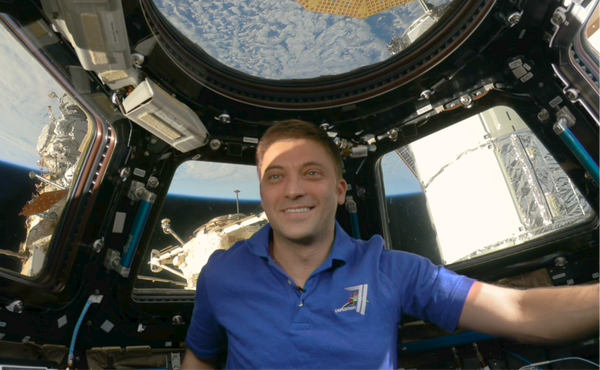
Kelso Harper/Scientific American
Rachel Feltman is former executive editor of Popular Science and forever host of the podcast The Weirdest Thing I Learned This Week. She previously founded the blog Speaking of Science for the Washington Post.
Kelso Harper is an award-winning senior multimedia editor at Scientific American. As a producer, editor and host, they work on short documentaries, social videos and Scientific American’s podcast Science Quickly. They have a bachelor’s degree in chemistry from Johns Hopkins University and a master’s degree in science writing from the Massachusetts Institute of Technology. Previously, they worked with Wired, Science, Popular Mechanics, and MIT News. Follow them on LinkedIn and Instagram.
Fonda Mwangi is a multimedia editor at Scientific American. She previously worked as an audio producer at Axios, The Recount and WTOP News. She holds a master’s degree in journalism and public affairs from American University in Washington, D.C.
Jeffery DelViscio is currently chief multimedia editor/executive producer at Scientific American. He is former director of multimedia at STAT, where he oversaw all visual, audio and interactive journalism. Before that he spent more than eight years at the New York Times, where he worked on five different desks across the paper. He holds dual master's degrees in journalism and in Earth and environmental sciences from Columbia University. He has worked onboard oceanographic research vessels and tracked money and politics in science from Washington, D.C. He was a Knight Science Journalism Fellow at the Massachusetts Institute of Technology in 2018. His work has won numerous awards, including two News and Documentary Emmy Awards.
[enclosures] => Array ( ) [categories] => Array ( ) [uid] => [link] => https://www.scientificamerican.com/podcast/episode/astronaut-matthew-dominick-speaks-to-scientific-american-live-from-the/ [description] =>We spoke with NASA astronaut Matthew Dominick in an exclusive, first-ever interview from the cupola of the International Space Station.
[pubDate] => Mon, 07 Jul 2025 10:00:00 +0000 [guid] => https://www.scientificamerican.com/podcast/episode/astronaut-matthew-dominick-speaks-to-scientific-american-live-from-the/ ) [45] => Array ( [uri] => https://www.scientificamerican.com/article/maths-block-stacking-problem-has-a-preposterous-solution/ [title] => Math’s Block-Stacking Problem Has a Preposterous Solution [timestamp] => 1751752800 [author] => Jack Murtagh; Jeanna Bryner [content] =>In principle, this impossible math allows for a glue-free bridge of stacked blocks that can stretch across the Grand Canyon—and into infinity
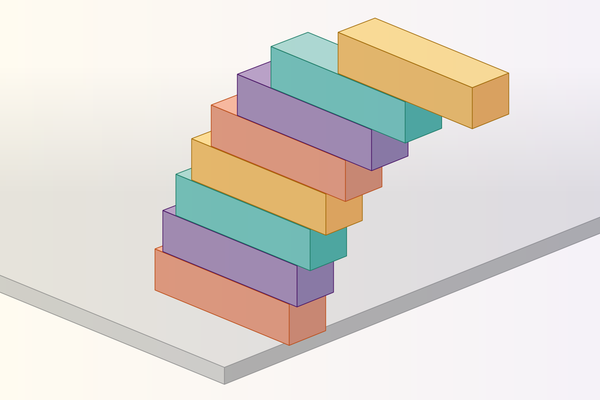
Amanda Montañez
Jack Murtagh is a freelance math writer and puzzle creator. He writes a column on mathematical curiosities for Scientific American and creates daily puzzles for the Morning Brew newsletter. He holds a Ph.D. in theoretical computer science from Harvard University. Follow Jack on X @JackPMurtagh
[enclosures] => Array ( ) [categories] => Array ( ) [uid] => [link] => https://www.scientificamerican.com/article/maths-block-stacking-problem-has-a-preposterous-solution/ [description] =>In principle, this impossible math allows for a glue-free bridge of stacked blocks that can stretch across the Grand Canyon—and into infinity
[pubDate] => Sun, 06 Jul 2025 11:00:00 +0000 [guid] => https://www.scientificamerican.com/article/maths-block-stacking-problem-has-a-preposterous-solution/ ) [46] => Array ( [uri] => https://www.scientificamerican.com/article/climate-changes-fingerprints-came-early-a-thought-experiment-reveals/ [title] => Climate Change’s Fingerprints Came Early, a Thought Experiment Reveals [timestamp] => 1751580000 [author] => Ben Santer; Susan Solomon; David W. J. Thompson; Qiang Fu [content] =>Climate change left its signature on the atmosphere early in the industrial revolution, reveals a thought experiment investigation
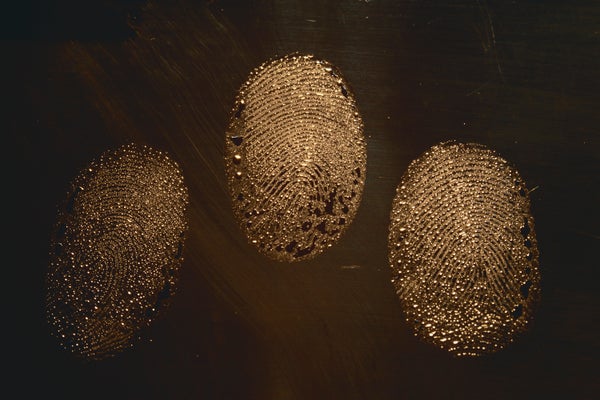
Ashley Cooper/Getty Images
Ben Santer is a climate scientist and John D. and Catherine T. MacArthur fellow, and an author or contributor to all six reports by the Intergovernmental Panel on Climate Change.
Susan Solomon is a professor in Earth, atmospheric and planetary sciences at the Massachusetts Institute of Technology.
David W. J. Thompson is a professor in the department of atmospheric sciences at Colorado State University and in the School of Environmental Sciences at the University of East Anglia.
Qiang Fu is a professor in the department of atmospheric and climate science at the University of Washington.
[enclosures] => Array ( ) [categories] => Array ( ) [uid] => [link] => https://www.scientificamerican.com/article/climate-changes-fingerprints-came-early-a-thought-experiment-reveals/ [description] =>Climate change left its signature on the atmosphere early in the industrial revolution, reveals a thought experiment investigation
[pubDate] => Fri, 04 Jul 2025 14:00:00 +0000 [guid] => https://www.scientificamerican.com/article/climate-changes-fingerprints-came-early-a-thought-experiment-reveals/ ) [47] => Array ( [uri] => https://www.scientificamerican.com/article/workers-have-died-in-extreme-heat-as-osha-has-debated-protections/ [title] => Workers Have Died in Extreme Heat as OSHA Has Debated Protections [timestamp] => 1751580000 [author] => Ariel Wittenberg; E&E News [content] =>The June heat dome contributed to the deaths of at least three people. They have died as federal regulators have weighed whether to finalize the nation’s first heat protection rule for workers
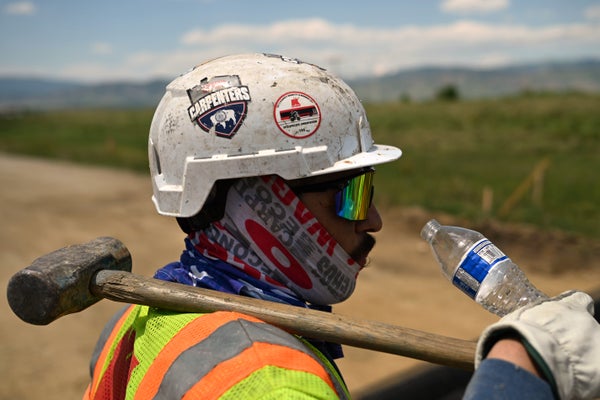
A construction worker drinks water during high 90-degree temperatures on June 20, 2025 in Boulder, CO.
Mark Makela/Getty Images
Ariel Wittenberg is a reporter covering public health for E&E News.
E&E News provides essential energy and environment news for professionals.
[enclosures] => Array ( ) [categories] => Array ( ) [uid] => [link] => https://www.scientificamerican.com/article/workers-have-died-in-extreme-heat-as-osha-has-debated-protections/ [description] =>The June heat dome contributed to the deaths of at least three people. They have died as federal regulators have weighed whether to finalize the nation’s first heat protection rule for workers
[pubDate] => Fri, 04 Jul 2025 12:00:00 +0000 [guid] => https://www.scientificamerican.com/article/workers-have-died-in-extreme-heat-as-osha-has-debated-protections/ ) [48] => Array ( [uri] => https://www.scientificamerican.com/article/human-gut-bacteria-can-gather-up-pfas-forever-chemicals/ [title] => Human Gut Bacteria Can Gather Up PFAS ‘Forever Chemicals’ [timestamp] => 1751580000 [author] => Nora Bradford; Sarah Lewin Frasier [content] =>When tested on their own and in mice, these bacterial strains from the human microbiome show promise in accumulating PFAS
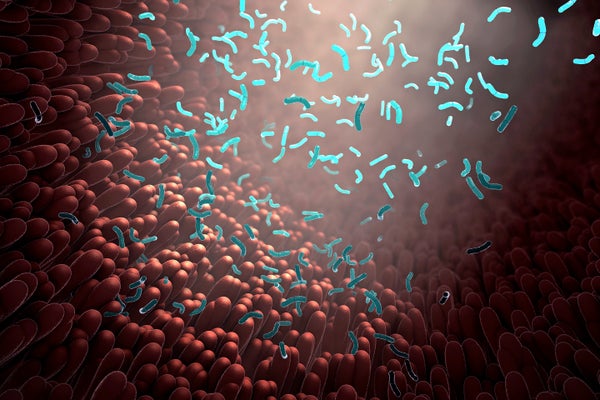
Gut microbiome bacteria from humans can absorb PFA.
Christoph Burgstedt/Science Source
Nora Bradford is the current news intern at Scientific American, a freelance science writer and a Ph.D. student in cognitive science. Follow Bradford on Blusky @norabradford.bsky.social
[enclosures] => Array ( ) [categories] => Array ( ) [uid] => [link] => https://www.scientificamerican.com/article/human-gut-bacteria-can-gather-up-pfas-forever-chemicals/ [description] =>When tested on their own and in mice, these bacterial strains from the human microbiome show promise in accumulating PFAS
[pubDate] => Fri, 04 Jul 2025 11:30:00 +0000 [guid] => https://www.scientificamerican.com/article/human-gut-bacteria-can-gather-up-pfas-forever-chemicals/ ) [49] => Array ( [uri] => https://www.scientificamerican.com/article/can-life-survive-the-death-of-the-sun/ [title] => Can Life Survive the Death of the Sun? [timestamp] => 1751493600 [author] => Phil Plait; Lee Billings [content] =>The future is bright—too bright—for life as we know it once the sun transforms into a red giant star
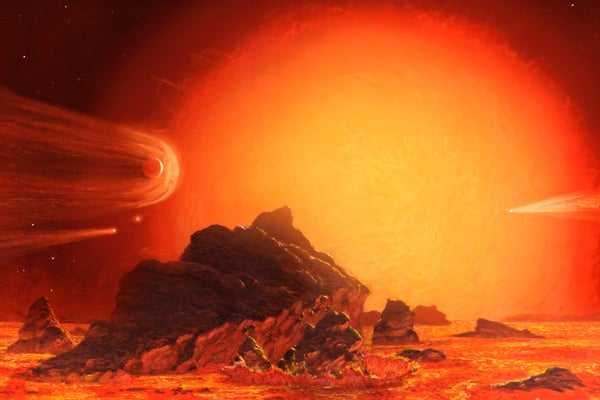
An artist’s impression of the far-future sun, swollen to become a red giant star, as seen from a molten Earth landscape.
Chris Butler/Science Source
Phil Plait is a professional astronomer and science communicator in Virginia. His column for Scientific American, The Universe, covers all things space. He writes the Bad Astronomy Newsletter. Follow him online.
[enclosures] => Array ( ) [categories] => Array ( ) [uid] => [link] => https://www.scientificamerican.com/article/can-life-survive-the-death-of-the-sun/ [description] =>The future is bright—too bright—for life as we know it once the sun transforms into a red giant star
[pubDate] => Fri, 04 Jul 2025 10:45:00 +0000 [guid] => https://www.scientificamerican.com/article/can-life-survive-the-death-of-the-sun/ ) ) )